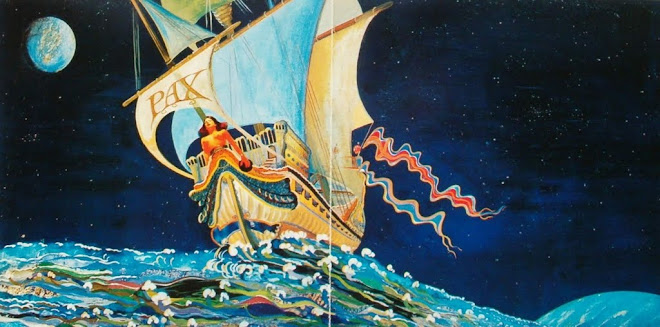By Ann Taylor (Aug 19, 2010 )
Before MP3s, CDs, cassette tapes, and even 8-tracks, there was vinyl. And during the reign of vinyl, album covers were high art, often rivaling the very music they encased.
Annie Liebovitz, Robert Mapplethorpe, H.R. Giger, even Andy Warhol have put their hand to the design of album covers, the large format providing a perfect canvas for some of the most well-known images in the world.
But one of the most lasting impressions has been left by Storm Thorgerson, the man behind Pink Floyd album covers since 1968 — including the iconic Dark Side of the Moon — as well as covers for Led Zeppelin, Peter Gabriel, Steve Miller Band, Black Sabbath, and the Cranberries, among others. Currently showing at the San Francisco Art Exchange’s Lovers of Covers show are more than sixty prints of his celebrated works and several originals.
While Pink Floyd’s Dark Side of the Moon cover is undoubtedly Thorgerson’s most famous work, and perhaps the most famous album cover of all time, it is not particularly representative of his typical visual style — Lovers of Covers allows viewers to see that work within the broader context of Thorgerson’s overall ouevre.
Typical of Thorgerson’s work is a surreal, dreamlike quality as well as odd juxtapositions of objects in expansive landscapes, creating quite dramatic compositions, such as the cover for Disco Biscuit’s Planet Anthem. Four women, carefully wrapped in brown butcher paper and tied with string, are ranged across a sandy beach. Like packages of meat at the supermarket, their wrapped forms are inert yet promising, set off dramatically against a cloudless sky as a white sheet floats gently in the breeze.
Along similar lines is the art for The Cranberry’s Bury the Hatchet album, in which a lone naked man cowers in the desert, tiny mesas visible in the far distance behind him, a giant eye staring at him from above. The flatness of the desert and the expansiveness of the clear sky emphasize his nakedness, his vulnerability to the all-seeing eye. These Magritte-esque images seem to tap into nightmare worlds, framing them in desolation and unexpected blue skies.
Even Thorgerson’s more simple images reflect an unexpected complexity and masterful composition. The cover for Pink Floyd’s Ummagumma, for instance, looks, on the surface, like a picture of the band members casually relaxing in a doorway — scruffy, barefoot rock ’n’ rollers sitting around on a warm summer day. Yet, a second look reveals that the frame to the left of guitarist David Gilmour, who is slumped on a stool in the foreground, is a repeat of the same scene, stretching on into infinity like a reflection of a reflection in a mirror.
An even closer examination discloses a subtle change in each subsequent reframing of the scene: the band members are switching positions. Roger Waters now sits slumped on Gilmour’s stool, Nick Mason has taken Waters’ old position on the floor with knees bent, Richard Wright assumes Mason’s former standing pose with arms akimbo, and Gilmour now scissors his legs in the air in the background, where Wright is in the larger frame. And so on. It is little surprises like these that make even the mundane remarkable in Thorgerson’s work.
However, his covers are not just interesting but empty images; they also tend to point to an idea, a story, or even a joke (see the Steve Miller Band’s Let Your Hair Down, Baby cover). Most, if not all, of Thorgerson’s breathtaking compositions are backed by thoughtful concepts, and depict visual representations of those concepts, such as the artwork for The Mars Volta’s Frances the Mute album or Pink Floyd’s Delicate Sound of Thunder — you can read about them for yourself at the show.
Forty years of rock ’n’ roll history is bound up in stunning visuals in Lovers of Covers, reminding us of the power of the image even in the world of music. This show is not to be missed.
San Francisco Art Exchange
Through September 15th
Free














.jpg)



No comments:
Post a Comment